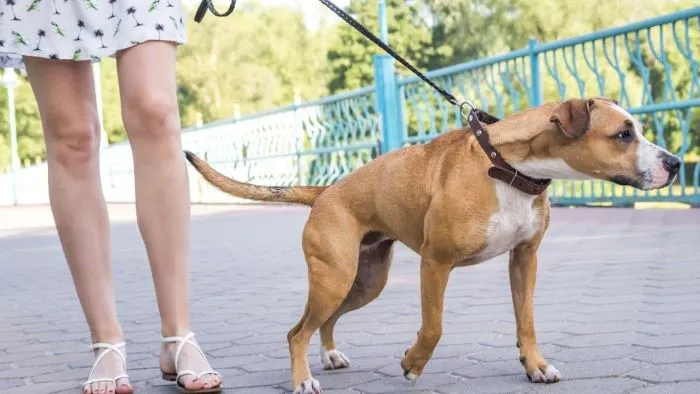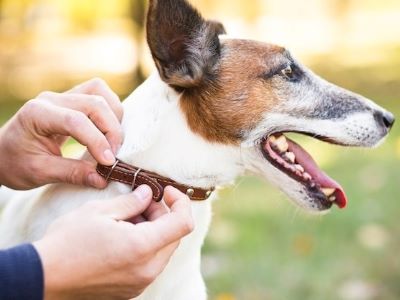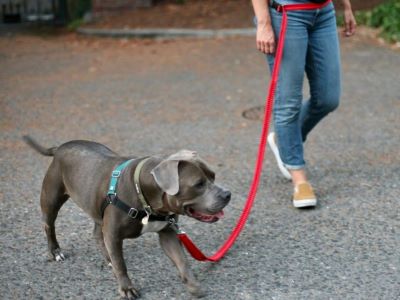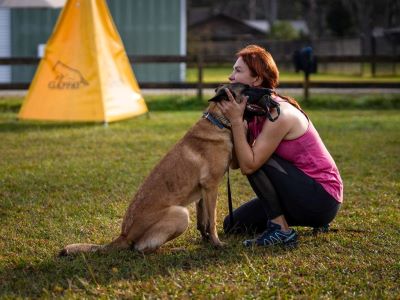Are you one of those owners who loves walking with their dogs, but are frustrated because their dogs pull on a lead? Do you feel like you have no control over your dog’s behaviour and that they are the ones walking you? Then, this blog is for you! Many dog owners struggle with this common problem and wonder, “How to Stop a Dog Pulling on Lead?”
Pulling on a lead is not only frustrating and exhausting for you, but also dangerous for your dog. It can cause neck injuries, breathing difficulties and even accidents. Moreover, it can prevent you from enjoying a relaxed bonding time with your furry friend. But, why do dogs pull on the lead and how to stop them? Let us dive deeper and explore some reasons as well as solutions to lead pulling.

How to Stop a Dog Pulling on Lead?
Your dog pulling the lead could turn the peaceful walk into a chaotic one. Here are some tips you can use to stop a dog from pulling the lead:
- Use safe and comfortable collars and harnesses for your dog, this will provide them comfort. With comfort, the dog will walk with ease and avoid pulling the lead.
- Treat your dog with the treats. Take your dog for a walk and command them to not pull the lead. If they follow your command then give them the treats this will encourage them to not pull the lead and walk peacefully.
- If you see your dog pulling the lead then stop walking and continue only when your dog returns back. Doing this will make the dog realise that pulling lead only slows them down and they won’t do it again.
- Be patient throughout the walk and avoid the route with distractions. Dogs tend to pull the lead by sighting the distractions.
- If you are not able to teach your dog to stop pulling the lead then take the help of professionals. These professionals are specialised in training the dogs easily.
Why Do Dogs Pull on a Lead?
Pulling is a natural behaviour of dogs.[1] Walking on a lead is not something they are trained or inherited for. Therefore, they often pull on the lead to go to their desired place. Generally, pet owners take the dog 🐕 in the direction he is pulling. This encourages pulling.
Dogs are wrongly reinforced with the behaviour. They think that the owner will take him to the desired place when he pulls the lead and it actually works. You take the dog where he leads you, rather you should walk your dog!
“Leash walking skill is something that needs to be trained. It’s an important skill to teach, and one you’ll value every time you take your dog 🐶 out for a walk.“, confirms Kathy Santo at the American Kennel Club.
Paw parents are attracted towards leash training their dogs. Practising loose training is a difficult task but not an impossible one. If your dog is used to pulling then he might not easily give away the behaviour. But, with consistent training and practice your dog will learn not to pull on a lead.
Some factors due to which a dog pulls on a lead are:
- Lack of proper training and socialization
- Lack of exercise and mental stimulation
- Lack of trust between the dog and the owner
- inappropriate or ill-fitted equipment
- Fear, anxiety and aggression
What Equipment Does Your Dog Need?
It is crucial to choose the types of equipment to teach politeness to the dog 🐶 while on a leash. Some important training tools are leashes, collars and harnesses.
- Leashes
Choose a fixed-length leash of about 5-10 m in length that you and your dog are comfortable with. You should ensure that the leash is broad enough for you to hold firmly without any friction cuts and burns. Also, it should be narrow enough to fit comfortably on the dog.
You can also keep a long-line lead along with you to extend the freedom. This can be particularly helpful in the backyard or personal garden where you can easily let your dog 🐶 explore beyond your personal boundaries. Consider using a double ended dog leads that attaches to both the collar and harness for added control and training. But make sure not to leave it on unsupervised.
Avoid the use of retractable lead as it can cause harm to the dog as well as people around. In personal spaces too, retractable leads are difficult to manage.
- Collars
There are various collars available in the market. Some are simple and flat to rest on the dog’s neck and others apply pressure on the neck, specially used for training purposes. If you choose to put a collar, put a simple one that is not too tight to choke the neck.

Training collars like slip, choke, prong or e-collars are harmful to dogs. They cause pain when the dog 🐕 pulls the lead. Moreover, training a dog with pain might disrupt your relationship with the dog leading to fear or aggression. Thus, avoid using training collars.[2]
- Harnesses
While choosing a harness for your dog you should consider one that is easy to put on and remove. Opt for a ‘no pull’ harness. A well-fitted H-style or Y-style harness can be a wonderful tool for many dogs. Make sure harnesses should only be worn when the dog 🐶 is on a leash.
Consider the size of the dog and body style, accordingly, find the right fit for the dog. When choosing a dog harness, consider how much or how hard your dog pulls. The wrong harness can make it easier for your dog to pull you around.
Some owners also use double ended dog leads, which allow you to control two dogs at once. For more information check out our guide on how to use double ended dog leads.
How to Stop a Dog Pulling on Lead?
Leash training a puppy is an easy task as he starts learning from a young age. On the flip side, dogs who have been pulling on the leash and have wrongly reinforced the behaviour find it difficult to learn not to pull. So, how to stop a dog pulling on lead? Though time-consuming, the training is worth it.

You can try any of these methods mentioned depending on the nature of your dog and teach him not to pull 🐕 on a lead.
The Stop-and-Go Method
As the name suggests, this method involves stopping every time your dog pulls on the lead and only moving forward when he stops pulling. The idea is to teach your dog 🐶 that pulling on the leash will lead him nowhere. He can only explore only if he obeys the owner that is you since you are leading the dog!
To use the method, follow these steps:
- Start walking with your dog on a loose lead by your side.
- As soon as your dog pulls on the lead, stop and stand still. Do not yank or jerk the lead, as this can hurt your dog and make them pull more.
- Wait patiently until your dog stops pulling and looks at you or comes back to you.
- When your dog stops pulling, reward them with a treat 🍖, praise 👏 or a clicker (if you use one). Then resume walking.
- Repeat this process every time your dog pulls on the lead.
Be consistent and do not let your dog get away with pulling. Eventually, your dog will learn that pulling is not rewarding and that walking by your side is.
The Turn-Around Method
This method involves changing direction every time your dog pulls on the lead. Once your dog stops pulling you should only walk in the direction that you want not what your dog wants. The idea is to teach your dog to pay attention to you and follow your cues.
To use the method, follow these steps:
- Start walking with your dog on a loose lead by your side.
- As soon as your dog pulls on the lead, say “no” or “stop”, turn around and walk in the opposite direction. Do not yank or jerk the lead, just calmly change direction and walk away from what your dog wants.
- When your dog catches up with you and walks by your side, reward him 🦴 with a treat, praise or a clicker (if you use one). Then resume walking in the direction that you want.
- Repeat this process every time your dog pulls on the lead.
The Lure-and-Reward Method
This method involves using a treat or a toy to lure your dog 🐶 to walk by your side and rewarding them for doing so. The idea is to teach your dog that walking by your side is fun and rewarding.
To use the method, follow these steps:
- Start by walking your dog on a loose lead by your side.
- Hold a treat or a toy in front of your dog’s nose and lure them to walk by your side. You can use a cue word such as “heel” or “with me” to signal what you want them to do.
- When your dog walks by your side, reward them 🍖 with a treat, praise, or a clicker. Then repeat the process with another treat or toy.
- Gradually increase the distance and duration that your dog walks by your side before rewarding them.
You can also vary the speed and direction of your walk to make it more interesting for your dog. Eventually, phase out the treats or toys and reward your dog with praise or occasional treats.
Common Mistakes to Avoid
Teaching your dog not to pull 🐕 on a lead is a challenging task. It requires a lot of your time and patience. But with patience and consistency, your dog can be well-trained to walk politely on a lead. However, you should avoid some mistakes in order to make the learning process smooth.

These are some common mistakes you should avoid:
- Giving up too soon: You cannot expect your dog to learn overnight or after a few sessions. You need to practice regularly and reinforce the behaviour that you want. Do not give up if you face some setbacks.
- Punishing the dog: Using force or punishment can make the problem worse. It can cause pain, fear or aggression in your dog, which can make walking unpleasant for both of you. It can also make your dog associate the lead with something negative.
- Being inconsistent: Being inconsistent when training can confuse the dog. If you sometimes let them pull and sometimes stop them, they will not know what you expect. Be consistent and stick to one method and one cue until they master it.
- Being distracted: When you are distracted, you are not paying attention to your dog’s behaviour and signals. This can hinder their progress and make them lose interest in you. You are also missing opportunities to reward 🦴 them for good behaviour. You need to be focused and attentive when training your dog not to pull on the lead.
FAQs
Do dogs naturally stop pulling on leashes?
For most dogs, pulling against a constraint is natural and can be difficult to make them learn once it becomes rooted. That’s why vets and behaviourists recommend teaching your pup early, between eight weeks and five months old. Start practising loose leash walking in your house to get your dog used to the leash or harness.
At what age do you leash train a puppy?
You can start the process as early as four to six weeks of age, though ten weeks old is a great age to start leash training a puppy. By this time, your puppy should be aware of when they need to go out to urinate or defecate. They should also understand when you’re happy with their good behaviour.
Why does my dog pull on the leash?
Many dogs pull because the objects surrounding them that stimulate their senses are more interesting than the person on the other end of the leash (that is you). Pay attention to your dog and teach him what you’d like him to do, rather than just allowing him to lead.
Can you teach an old dog to stop pulling on a leash?
Absolutely! All you need to do is keep up with the training and be patient. It may take many weeks and hours of slow and disjointed walks, but your old dog will eventually stop pulling on a lead.
Wrapping Up
So, how to stop a dog pulling on a lead? Well, pulling on the lead is a common problem that many dog owners face, but it can be solved with proper training and positive reinforcement. Walking your dog is one of the most important and enjoyable activities that you can do with your furry friend. However, it can also be one of the most frustrating and exhausting if your dog pulls on the lead.
Now, it’s your turn to teach your dog not to pull on the lead. Don’t forget to take along with your patience, consistency and positivity. Remember that every dog is different and that you may need to try different methods or adjust them according to your dog’s needs and personality. Happy training! 🐕
Remember, while training equipment and methods are important, so is how you handle the lead. Learn how to hold a dog lead properly for maximum control and an enjoyable walking experience
References:
- Most Common Bad Dog Behavior Issues and Solutions. (n.d.). Student Review from Pennsylvania State University.
- Blackwell, E., Bolster, C., Richards, G., Loftus, B., & Casey, R. (2012). The use of electronic collars for training domestic dogs. BMC Veterinary Research.



